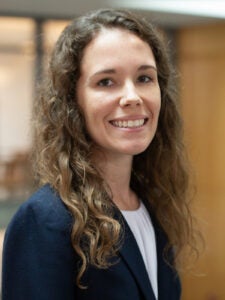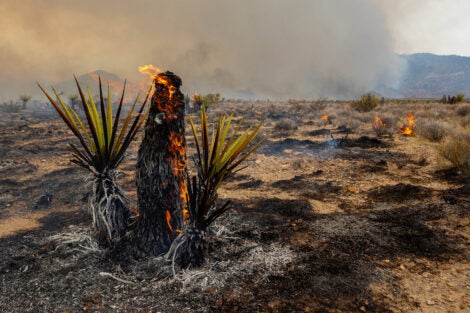October 13, 2023 — Rachel Nethery, assistant professor of biostatistics at Harvard T.H. Chan School of Public Health, uses her quantitative skills to tackle big questions in environmental health.

Q: Where did you grow up, and what was your community like?
A: I grew up in rural Kentucky. My dad was a farmer and a farrier—meaning, he put shoes on horses. Ironically, given that I’m in public health, we raised tobacco when I was younger, but later we switched to primarily raising beef cows. It’s a very small, tight-knit community. All of my extended family lived within a few miles of my house.
Q: When did you become interested in math?
A: A lot of the farmers in my town managed their own finances, and they emphasized to me the importance of having quantitative skills regardless of my career direction. In my senior year of high school, my calculus and physics teachers showed me how I could bring my quantitative skills to bear on real-world problems. I found that exciting.
Q: How did you decide that statistics would be your field?
A: Everyone always told me I should become a lawyer, because I was good at arguing. But after I took a few law classes as an undergraduate at Georgetown, I realized that wasn’t the path for me. I wound up majoring in both mathematics and government because I had an interest in policy.
During my sophomore year, a professor encouraged me to apply for the Summer Institute in Biostatistics at Emory University [part of an NIH training program offered around the country]. That was an awesome experience that set me up on a path to getting a graduate degree in biostatistics. But I can’t say I had an aha moment where I felt sure that this is the right path for me. You can pursue an academic path in science without that moment of certainty. If you find something you enjoy, keep at it, and see where it goes.
Q: Your work focuses on developing new statistical methods for using data to answer environmental health questions. Why is there a need for new methods?
A: There has been an explosion of new, complex data sources in recent years. Often our classical statistical methods, developed to be used on more structured data sets like clinical trial data or survey responses, aren’t equipped to deal with them.
In environmental health, we’ve made really good progress towards developing methods that allow us to estimate the average effects of environmental exposures. These studies are observational—we wouldn’t want to run experiments where we expose people to pollution and see what happens—so we have to rely on data that captures variation in exposure that occur in people’s everyday lives. Increasingly these data come from sources like satellites and electronic health records.
The use of observational data sources like these can lead to a problem that we call confounding, meaning that people who are exposed to high levels of air pollution might be systematically different from people who are exposed to lower levels in ways that impact their health. For example, they might be more socioeconomically disadvantaged or more likely to smoke. Newer statistical methods allow us to disentangle the effects of these types of confounding factors and better estimate the average effects of different environmental exposures on health in a population.
I want to take one step further and figure out what makes some people or communities more vulnerable to the health impacts of exposures than others. We’ve only very recently started to develop methods that allow us to identify these drivers of vulnerability—with the ultimate goal of informing policies and guidelines to protect people.
Q: Early in the pandemic, you were co-lead author on a preprint study that was the first to link air pollution to increased risk of COVID-19 mortality. What were your biggest challenges in developing the study and also dealing with the heightened publicity that followed its release?
A: We had a lot of good air pollution data, but like most other researchers, we faced data-quality challenges around COVID outcomes.
I was blown away by how much publicity the study received—I’d never been involved with research that had gotten any significant media attention—but I was surprised that it didn’t become more politicized than it was. The vast majority of the feedback we received was positive or at least constructive. We even presented our results and had a discussion with policymakers in both the U.S. Congress and the U.K. Parliament, and everybody seemed genuinely interested in learning.
Our biggest challenge was around communicating our results to the public. As was true with many of the high-profile COVID-related studies, we found it challenging to bring people to appreciate the importance and value of the work while also acknowledging that it is inevitably subject to errors and limitations. Even if there aren’t any errors in the data sources, there is still uncertainty related to statistical analysis. Science is a process of iteratively refining and improving our approach to minimize those kinds of problems. Other groups that had access to more robust COVID data later in the pandemic have been refining and improving the work we did in that first study, which is how science is supposed to work. Overall, they’ve been upholding our findings.
Q: You recently received funding from Harvard to study the health impacts of wildfire smoke in the Western U.S. What are the goals of this project?
A: We don’t know much about the impacts of wildfires on health, beyond a limited literature on cardiovascular and respiratory effects. This is preventing us from being able to take action to reduce wildfire health burdens. So, the first aim of our work is to unveil the full scope of health impacts by investigating the effects of wildfire smoke exposure on a wide range of health outcomes. Then, we’re going to try to identify the communities that have the largest wildfire-smoke health burdens and to determine the community, social, economic, geographic, and meteorological factors that are contributing to their vulnerability.
The hope is that this work will inform policy around allocating resources and implementing resilience-building programs in communities that are affected by climate change–related health burdens.
Q: What other research questions do you want to explore?
A: How researchers can directly inform policy—not just what effect does an exposure have on health—but how can we allocate our limited resources to save the most lives, prevent the most adverse impacts, and reduce health disparities? I would also like to get involved in projects related to mental health and substance-use disorders.
Photos: AP Photo / Ty O’Neil (top), Kent Dayton (left)
